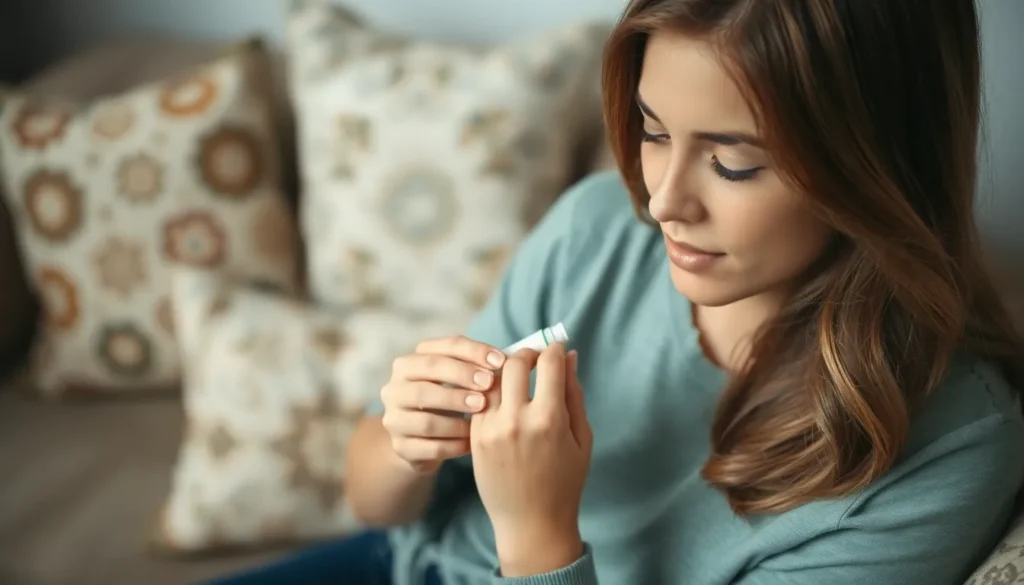Table of Contents
ToggleGetting a new ear piercing can feel like a rite of passage, but what happens when that shiny new accessory turns into a pesky infection? Fear not! With the right antibiotic ointment, healing can be as smooth as your favorite playlist. Picture this: you’re flaunting those earrings, but first, you’ve got to tackle that unexpected irritation.
Overview of Ear Piercing Infections
Ear piercing infections occur when bacteria enter the skin through the piercing site. Symptoms often include redness, swelling, and discharge. Discomfort may intensify, resulting in pain around the area. Identifying these signs early is essential for effective treatment.
Several factors contribute to infections. Piercing guns can increase the risk of complications due to blunt force trauma. Using unsterilized equipment also heightens the chances of infection. Poor aftercare, such as touching piercings with unwashed hands, can further exacerbate these issues.
Infected piercings require prompt attention to prevent further complications. Delaying treatment might lead to more severe infections, possibly resulting in scarring or the formation of abscesses. Seeking medical advice helps in determining whether over-the-counter antibiotic ointments suffice or if prescription medications are necessary.
Using the right antibiotic ointment enhances recovery. Products containing ingredients like bacitracin and polymyxin B prove effective in treating superficial infections. Application typically involves a thin layer on the affected area. Consistency in using ointments aids in minimizing irritation and promoting healing.
Monitoring the healing process is crucial. Any persistent symptoms necessitate consultation with a healthcare professional. Following aftercare guidelines helps mitigate the risk of both infection and irritation. Keeping the area clean and dry fosters a healthier environment for healing.
Signs and Symptoms of Ear Piercing Infections

Recognizing signs and symptoms of ear piercing infections is crucial for prompt treatment. Redness around the piercing site often indicates inflammation caused by bacteria. Swelling may accompany this redness, signaling that the body is responding to an infection. Discharge that appears yellow or green suggests pus buildup, a clear sign of infection requiring attention.
Pain or tenderness near the piercing also points to infection. Worsening discomfort while touching or moving the earring can intensify concern. Increased warmth around the area often accompanies these other symptoms, hinting at underlying issues.
Fever may develop in some cases, indicating that the infection could be more severe and possibly systemic. If symptoms persist beyond a few days despite proper aftercare, immediate medical consultation becomes necessary.
Delayed treatment may lead to complications such as scarring or abscess formation. It’s essential to monitor the situation closely. Engaging with a healthcare provider can provide guidance tailored to specific symptoms.
Awareness and observation contribute significantly to effective management of ear piercing infections. Ignoring subtle changes can result in exacerbated conditions, reinforcing the importance of vigilance during the healing process.
Types of Antibiotic Ointments
Various antibiotic ointments help manage ear piercing infections. Choosing the right product can significantly enhance healing.
Top Recommended Antibiotic Ointments
Bacitracin remains a popular option due to its effectiveness against infection-causing bacteria. Neosporin, often preferred for its triple-action formula, combines bacitracin, polymyxin B, and neomycin for enhanced protection. Polysporin offers a gentler alternative, with a two-antibiotic formula suitable for sensitive skin. These choices provide reliable options for treating infections around ear piercings.
Comparison of Common Ointments
Bacitracin targets a broad spectrum of bacteria, making it effective for initial treatment. Neosporin includes unique ingredients that help prevent infection and promote healing, though it may cause irritation for some users. Polysporin, while gentler, focuses on preventing bacterial growth rather than offering comprehensive treatment. Evaluating these ointments helps determine the best fit based on individual needs and skin sensitivities.
How to Prevent Ear Piercing Infections
Choosing a reputable piercing studio is crucial for preventing infections. Look for places that use sterilized equipment and follow proper hygiene protocols. Selecting the right jewelry also plays a significant role. Opt for high-quality materials like surgical steel or titanium, as these reduce the risk of irritation.
Following aftercare instructions from the piercer is essential. Clean the piercing site with saline solution or alcohol-free antiseptic daily. Avoid twisting or playing with the earrings, which can introduce bacteria. Keeping hair away from the ear can prevent contamination from hair products.
Changing earrings too soon may lead to infections. Wait at least six weeks before switching out jewelry, allowing the piercing to heal completely. Avoid wearing ear coverings, such as hats or scarves, that may irritate the area during the initial healing phase.
Using antibiotic ointment can provide extra protection against bacteria. Apply a thin layer twice daily for the first week, ensuring that hands are clean before touching the area. Additionally, monitoring for signs of infection is important. Seek medical advice immediately if symptoms arise, such as increased redness, swelling, or discharge.
Engaging in activities like swimming in pools or hot tubs can expose the piercing to bacteria. Stay clear of these environments until the piercing has fully healed. Prioritizing prevention through these methods enhances the likelihood of a smooth healing journey, allowing individuals to enjoy their new piercings confidently.
Tips for Proper Ear Care After Piercing
Maintaining proper ear care post-piercing is crucial for optimal healing. Clean the piercing site regularly using saline solution or an alcohol-free antiseptic. Swabbing the area twice a day helps prevent bacteria growth.
Avoid touching or twisting earrings to reduce irritation. Jewelry made from surgical steel or titanium minimizes allergic reactions and supports healing.
Stay away from swimming pools and hot tubs during the initial healing phase. Exposure to contaminated water increases the risk of infection.
Changing earrings too soon can introduce bacteria to the fresh piercing. Wait at least six to eight weeks before switching out jewelry.
Wearing tight head coverings may irritate the new piercing. Opt for loose-fitting options during the healing process, allowing air access to the area.
Monitor the piercing closely for signs of infection. Symptoms include increased redness, swelling, and discharge; these require prompt attention. If concerns arise, consult a healthcare professional immediately.
Always prioritize the advice of professional piercers. They provide valuable aftercare recommendations tailored to specific types of piercings.
Patience plays a key role in the healing journey. Resist the urge to change jewelry or rush the process for the best results. Following these tips ensures a smooth and infection-free healing experience.
Choosing the right antibiotic ointment is crucial for anyone dealing with an ear piercing infection. By selecting effective options like bacitracin or Neosporin and adhering to aftercare guidelines, individuals can significantly reduce the risk of complications. Monitoring the healing process and recognizing signs of infection ensures prompt treatment and a smoother recovery.
It’s essential to prioritize proper hygiene and follow professional advice to maintain healthy piercings. With patience and care, enjoying new earrings can be a positive experience without the worry of infection.




